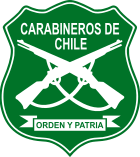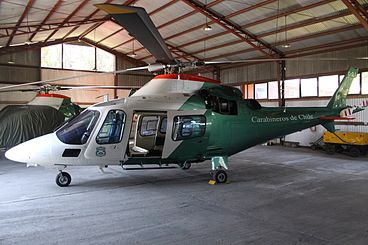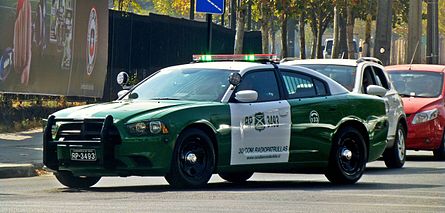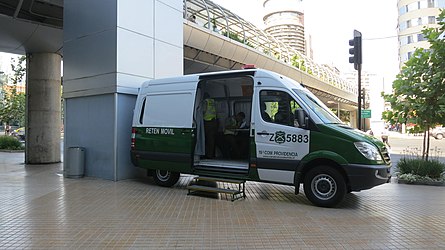Sergeant (Sgt) is a rank in use by the armed forces of many countries. It is also a police rank in some police services. The alternative spelling, serjeant, is used in The Rifles and other units that draw their heritage from the British light infantry. Its origin is the Latin serviens, 'one who serves', through the Old French term serjant.
Corporal is a military rank in use by the armed forces of many countries. It is also a police rank in some police services. The rank is usually the lowest ranking non-commissioned officer. In some militaries, the rank of corporal nominally corresponds to commanding a section or squad of soldiers.

A gendarmerie is a military force with law enforcement duties among the civilian population. The term gendarme is derived from the medieval French expression gens d'armes, which translates to "men-at-arms". In France and some Francophone nations, the gendarmerie is a branch of the armed forces that is responsible for internal security in parts of the territory, with additional duties as military police for the armed forces. It was introduced to several other Western European countries during the Napoleonic conquests. In the mid-twentieth century, a number of former French mandates and colonial possessions adopted a gendarmerie after independence. A similar concept exists in Eastern Europe in the form of Internal Troops, which are present in many countries of the former Soviet Union and its former allied countries.

A carabinier is in principle a soldier armed with a carbine, musket, or rifle, which became commonplace by the beginning of the Napoleonic Wars in Europe. The word is derived from the identical French word carabinier.
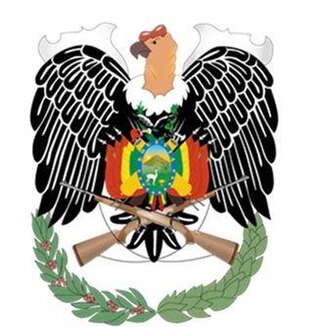
Law enforcement in Bolivia is reliant on the 40,000-member Cuerpo de Policía Nacional responsible for internal security and maintaining law and order. Unlike many South American countries, the Bolivian police force always has been accountable to the national government rather than to state or local officials. The 1950 Organic Law of Police and Carabiniers officially separated the police from the military. Frequently, however, the national police call upon the military for assistance in quelling riots and civil protests.
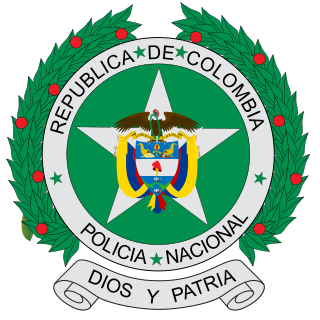
The National Police of Colombia is the national police force of the Republic of Colombia. Although the National Police is not part of the Military Forces of Colombia, it constitutes along with them the "Public Force" and is also controlled by the Ministry of Defense. The National Police is the only civilian police force in Colombia. The force's official functions are to protect the Colombian nation, enforce the law by constitutional mandate, maintain and guarantee the necessary conditions for public freedoms and rights and to ensure peaceful cohabitation among the population.

The Carabineros was an armed carabiniers force of Spain under both the monarchy and the Second Republic. The formal mission of this paramilitary gendarmerie was to patrol the coasts and borders of the country, operating against fraud and smuggling. As such the Carabineros performed the dual roles of frontier guards and customs officials.

Concerns about human rights in Chile include discrimination against indigenous populations; societal violence and discrimination against women, children, and lesbian, gay, bisexual, and transgender (LGBT) people; child labor; and harsh prison conditions and treatment. Additional human rights concerns in the country include use of excessive force and abuse by security forces, isolated reports of government corruption, and anti-Semitism. Authorities generally maintain effective control over the security forces. However, security forces occasionally commit human rights abuses. The government generally takes steps to prosecute officials who commit abuses. Nevertheless, many human rights organizations contend that security officials accused of committing abuses have impunity.

Investigations Police of Chile are the civilian police of Chile. Founded in 1933, it is one of two Chilean police bodies, along with the law enforcement police: Carabineros de Chile. The PDI is the principal law enforcement arm of the Public Prosecutor's Office of Chile in criminal investigation.
The Agencia Nacional de Inteligencia (ANI) is the Chilean government national intelligence agency. Created in 2004, its mission is to coordinate, and advise the President on, intelligence. It is attached administratively to the Ministry of the Interior. Its current director is Gonzalo Yuseff Quiroz. The previous director was Gustavo Villalobos, who was also the last director of Directorate of Public Security and Information. ANI's budget is approximately US$4 million.

The Peruvian Investigative Police was a Peruvian plainclothes police unit, similar to the United States Federal Bureau of Investigation (FBI), which was meant to investigate crimes, gather intelligence, and fight subversion. In 1988, the PIP was merged into the National Police of Peru, along with two other police forces, the Guardia Civil (GC) and the Guardia Republicana (GR), all three of which were under the direction of the Ministry of Interior.
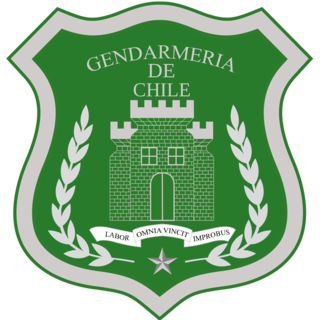
The Chilean Gendarmerie, is the title of Chile's uniformed national prison service military. The service evolved when Chilean Army units were given police and prison duties under president Carlos Ibáñez del Campo, a move that also created the Carabineros de Chile police force.
The Chilean honours system provides a means for the Government of Chile to reward gallantry, achievement, or service, by both Chileans and non-citizens. The honours system consists of three types of award: orders, decorations and medals. Membership of an Order is conferred to recognise merit in terms of achievement and service. Decorations are conferred to recognise specific deeds of gallantry, bravery, distinguished or meritorious service. Medals are conferred to recognise long and/or valuable service and/or good conduct. Awards to non-citizens are usually only made where the gallantry, achievement or service has advanced Chilean interests in some way. The honours conferred by the Chilean Republic can be divided into two groups: civil and military. Military honours are conferred by the different branches of the Armed Forces of Chile. Civil honours are conferred by the President of Chile or, in some instances, by the government minister relevant to the particular honour.
Following the 1973 Chilean coup d'état, an armed leftist resistance movement against Augusto Pinochet's dictatorship developed until 1990 when democracy was restored. This conflict was part of the South American theater in the Cold War, with the United States backing the Chilean military and the Soviet Union backing the guerrillas. The main armed resistance groups of the period were the Revolutionary Left Movement (MIR) and Frente Patriótico Manuel Rodríguez (FPMR), the armed wing of the Communist Party of Chile. These groups had a long-standing rivalry, including over Marxist orthodoxy and its implementation.

For more than a century the Military Parade of Chile or Great Military Parade of Chile has been a tradition within the Independence Day holidays in Chile. It is held in Santiago, Chile's O'Higgins Park on September 19 yearly in honor of the Glories of the Chilean Army with a military parade involving not just the ground forces but by the rest of the Chilean Armed Forces: the Chilean Navy, the Chilean Air Force, and the Carabineros de Chile. It is also in honor of the anniversary of the formal inauguration on that day in 1810 of the First Government Junta, which witnessed the first military parade of the independent nation at the Plaza de Armas, Santiago. It is the final act of the national independence celebrations, which are broadcast through TV and the Internet and radio.
The Group of Personal Friends, sometimes referred to by the Spanish acronym GAP, was the informal name of an armed guard of the Socialist Party of Chile maintained from 1970 to 1973 for the protection of Salvador Allende. The GAP was trained and equipped by Cuba and initially composed of ex-guerrilla fighters.
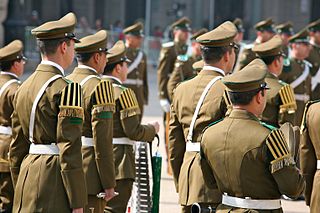
The National Band of the Carabineros sometimes referred to as the Orfeón Nacional is the public police band of the Carabineros de Chile, the national police force of the Republic of Chile. It is generally seen as the premiere representative marching band of the force, performing at state occasions. At the command of the band is Colonel David Ormeño Sepúlveda.
The military ranks and insignia of Chile are the military insignia used by the Chilean Armed Forces.
